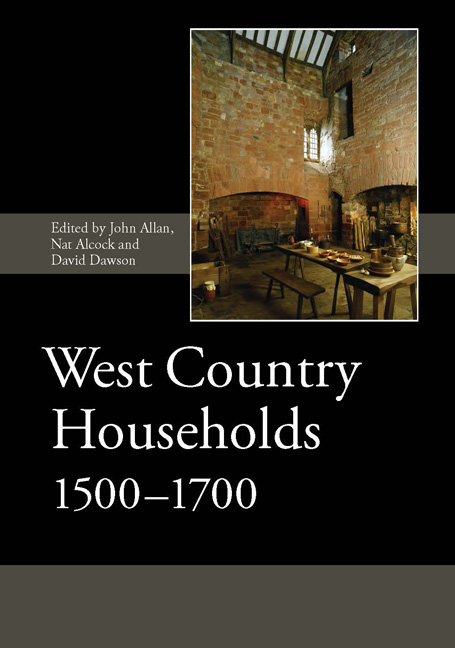Book contents
- Frontmatter
- Dedication
- Contents
- List of Illustrations
- List of Contributors
- List of Abbreviations
- Introduction
- I The Form and Development of West Country Houses
- II The Decoration of West Country Houses
- 5 The Polychrome-Decorated Plank-and-Muntin Screen at Marker's Cottage, Broadclyst, Devon, and its Context
- 6 The Interior Decoration of an Elizabethan Merchant's House: the Evidence from 41–2 High Street, Exeter
- 7 Sgraffito-Decorated and Painted Plaster on Devon Fireplaces
- 8 North Devon Relief-Decorated Ceramics in the Household
- 9 The Stained Hangings at Yarde Farm, Malborough, South Devon
- III The Material Culture of West Country Households
- Index of People and Places
- Index of Subjects
5 - The Polychrome-Decorated Plank-and-Muntin Screen at Marker's Cottage, Broadclyst, Devon, and its Context
from II - The Decoration of West Country Houses
Published online by Cambridge University Press: 05 May 2015
- Frontmatter
- Dedication
- Contents
- List of Illustrations
- List of Contributors
- List of Abbreviations
- Introduction
- I The Form and Development of West Country Houses
- II The Decoration of West Country Houses
- 5 The Polychrome-Decorated Plank-and-Muntin Screen at Marker's Cottage, Broadclyst, Devon, and its Context
- 6 The Interior Decoration of an Elizabethan Merchant's House: the Evidence from 41–2 High Street, Exeter
- 7 Sgraffito-Decorated and Painted Plaster on Devon Fireplaces
- 8 North Devon Relief-Decorated Ceramics in the Household
- 9 The Stained Hangings at Yarde Farm, Malborough, South Devon
- III The Material Culture of West Country Households
- Index of People and Places
- Index of Subjects
Summary
Paintings have been discovered on the screen separating the hall from the parlour of Marker's Cottage, Broadclyst, a three-room and cross-passage house of late medieval date. The character and structural history of the house are described. The paintings' early date (c. 1520–50) and their combination of religious and secular themes make them unique in a vernacular context. This paper relates them to other examples of painting on domestic West Country screens and to some contemporary work on church rood screens. Basic analysis has demonstrated that a more expensive and elaborate range of pigments was used than is apparent from visual examination.
INTRODUCTION
The plank-and-muntin screen, separating the principal ground-floor rooms, is a characteristic feature of the late medieval West Country house. Although many examples have survived, only a few preserve their painted decoration, since most have been stripped to the bare oak below, or retain only fragmentary traces of painted ornament. This paper records a remarkable addition to the small canon of decorated screens, found at Marker's Cottage, Broadclyst. The scheme dates from c. 1520–50 and displays a combination of religious and secular themes which appears to be unique in a vernacular context in the West Country.
The screen was discovered when Marker's was examined in the course of the Vernacular Buildings Survey set up by the Devon Region of the National Trust in 1985. The survey reflected a national decision to evaluate historically the small buildings held by the Trust, following criticism of the treatment of some of its cottages in which important features had not been recognized. Conducted under the auspices of the Manpower Services Commission and led by Gwynneth Guy, the scheme recorded, by survey and documentary research, every farmstead and cottage owned by the Trust in the county. In each case ground- and first-floor plans were measured and drawn; the materials used and external and internal features were noted, and photographs taken.
- Type
- Chapter
- Information
- West Country Households, 1500–1700 , pp. 117 - 140Publisher: Boydell & BrewerPrint publication year: 2015



